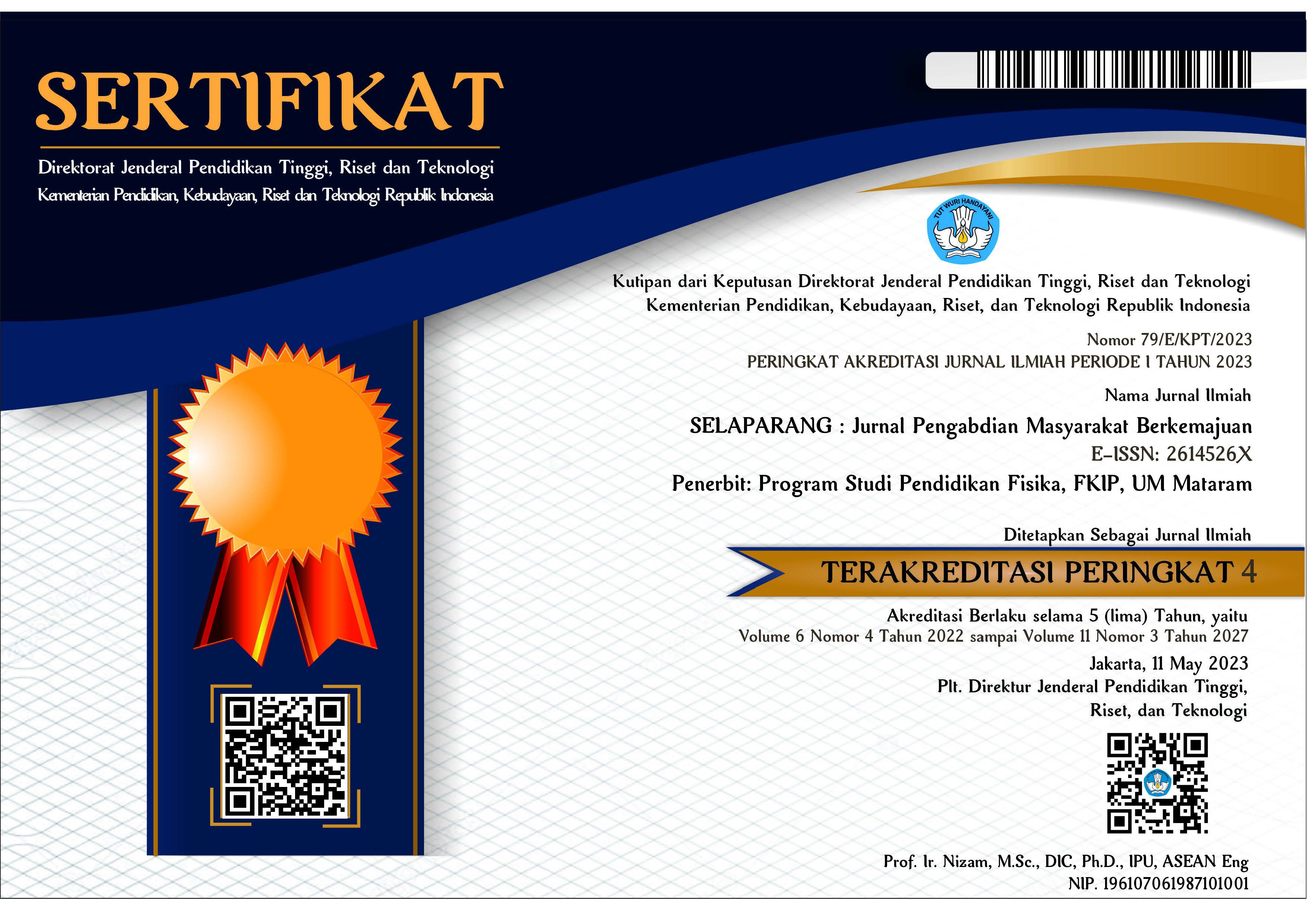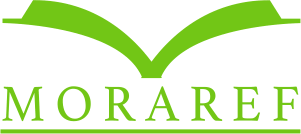Pendampingan pengolahan pakan melalui teknologi Solid State Fermentation limbah kulit kopi di kelompok ternak sapi di Kabupaten Bondowoso, Jawa Timur
Abstract
Abstrak
Permasalahan pakan menjadi salah satu kendala yang dialami oleh masyarakat peternak sapi potong di kabupaten Bondowoso, Jawa Timur. Sistem pengoleksian pakan cut and carry sulit dilakukan pada musim kemarau. Sebagian besar lahan pertanian di kabupaten Bondowoso merupakan lahan Perkebunan kopi. Limbah kulit kopi yang dihasilkan dari industry kopi di kabupaten Bondowoso masih kurang optimal. Kulit kopi memiliki kandungan nutrient yang masih potensial untuk dapat digunakan sebagai pakan ternak. Keberadaan antinutrisi dan rendahnya kecernaan menjadi faktor pembatas dalam pemanfaatannya sebagai pakan ternak. Pengabdian ini bertujuan untuk meningkatkan keterampilan peternak dalam menyediakan pakan ternak sapi potong yang bernilai gizi tinggi asal limbah kulit kopi melalui teknologi solid state fermentation. Kegiatan diawali dengan sosialisasi mengenai pakan komplit untuk ternak sapi potong, pelatihan pengolahan pakan asal kulit kopi, dan monitoring pemberian pakan pada ternak. Hasik kegiatan pengabdian menunjukan bahwa Masyarakat peternak sangat antusias mengikuti kegiatan baik sosialisasi, pelatihan maupun monitoring. Ternak sapi potong yang diberikan pakan komplit asal limbah kulit kopi melalui teknologi SSF selama 4 bulan juga memiliki pertambahan bobot badan yang lebih tinggi yaitu 144 kg dibandingkan ternak sapi yang hanya diberi limbah kulit kopi tanpa diolah yaitu 120 kg.
Kata kunci: Bondowoso; sapi; pakan; fermentasi; kulit kopi
Abstract
The issue of feed availability is one of the major challenges faced by the beef cattle farming community in Bondowoso District, East Java. The cut-and-carry feed collection system becomes particularly difficult during the dry season. Most of the agricultural land in Bondowoso District is used for coffee plantations. However, the utilization of coffee husk waste produced by the local coffee industry remains suboptimal. Coffee husks contain nutrients that have the potential to be used as animal feed. Nevertheless, the presence of antinutritional factors and low digestibility limit their effectiveness as feed. This community service initiative aims to enhance farmers' skills in providing nutritionally rich beef cattle feed by utilizing coffee husk waste through solid-state fermentation technology. The program began with a socialization session on complete feed for beef cattle, followed by training on how to process feed from coffee husks, and concluded with monitoring the implementation of feed usage for livestock. The results of the service activities show that the farming community was highly enthusiastic about participating in all aspects of the program, including socialization, training, and monitoring. Beef cattle that were fed complete feed made from coffee husk waste processed using solid-state fermentation (SSF) technology for four months showed a higher body weight gain of 144 kg, compared to those fed unprocessed coffee husk waste, which gained only 120 kg.
Keywords: Bondowoso; cattle; feed; fermentation; coffee husk.
Keywords
Full Text:
PDFReferences
Aswanto, A. A., Muhtarudin, M., Farda, F. T., Liman, L., & Tantalo, S. (2023). Potensi Nutrien Limbah Kulit Kopi Untuk Pakan Ternak Ruminansia Di Kecamatan Kebun Tebu Kabupaten Lampung Barat. Jurnal Riset Dan Inovasi Peternakan (Journal of Research and Innovation of Animals), 7(3), 306–311. Retrieved from https://doi.org/10.23960/jrip.2023.7.3.306-311
Betchem, G., Monto, A. R., Lu, F., Billong, L. F., & Ma, H. (2024). Prospects and Application of Solid-State Fermentation in Animal Feed Production – A Review. Annals of Animal Science, 24(4), 1123–1137. Retrieved from https://doi.org/10.2478/aoas-2024-0029
Chen, J., Wang, Z., Shen, X., Chen, R., Peng, Y., Cai, Y., … Ying, H. (2025). Solid-state fermentation through synthetic microbiome: An effective strategy for converting Chinese distillers’ grains into functional protein feed. International Journal of Food Microbiology, 435, 111154. Retrieved from https://doi.org/10.1016/j.ijfoodmicro.2025.111154
Chilakamarry, C. R., Mimi Sakinah, A. M., Zularisam, A. W., Sirohi, R., Khilji, I. A., Ahmad, N., & Pandey, A. (2022, January 1). Advances in solid-state fermentation for bioconversion of agricultural wastes to value-added products: Opportunities and challenges. Bioresource Technology. Elsevier Ltd. Retrieved from https://doi.org/10.1016/j.biortech.2021.126065
Fahmi, T., & Gustiani, E. (2022). Pendampingan Peternak dalam Upaya Mempertahankan Eksistensi Peternakan Sapi Potong Pasca Pandemi Covid 19 Di Kecamatan Cigasong Kabupaten Majalengka.
Harsita, P. A., & Amam. (2019). Permasalahan Utama Usaha Ternak Sapi Potong di Tingkat Peternak dengan Pendekatan Vilfredo Pareto Analysis. In Prosiding Seminar Nasional Teknologi Peternakan dan Veteriner 2019 (pp. 241–250). Pusat Penelitian dan Pengembangan Peternakan. Retrieved from https://doi.org/10.14334/Pros.Semnas.TPV-2019-p.241-250
Juwita, A. I., Mustafa, A., & Tamrin, R. (n.d.). Studi Pemanfaatan Kulit Kopi Arabika (Coffee arabica L.) sebagai Mikro Organisme Lokal (MOL).
Khasanah, H., Widianingrum, D. C., Purnamasari, L., Wafa, A., & Hwang, S.-G. (2022). Evaluation of coffee bean husk fermented by a combination of Aspergillus niger, Trichoderma harzianum, and Saccharomyces cerevisiae as animal feed. Jurnal Ilmu-Ilmu Peternakan, 32(3), 416–426. Retrieved from https://doi.org/10.21776/ub.jiip.2022.032.03.13
Khaswal, A., Mishra, S. K., Chaturvedi, N., Saini, S., Pletschke, B., & Kuhad, R. C. (2024). Microbial enzyme production: Unlocking the potential of agricultural and food waste through solid-state fermentation. Bioresource Technology Reports, 27, 101880. Retrieved from https://doi.org/10.1016/j.biteb.2024.101880
Kurniawan, W., Lestari, N. A., Isnaeni, P. D., & Sandiah, N. (2022). Different Composition of Indigofera zolingeriana and Corn Stover Mix on Silage Quality and Fermentation Characteristic. Retrieved from https://doi.org/10.2991/absr.k.220309.065
Purnamasari, L., Basuki, Khasanah, H., & Sari, V. K. (2023). Penguatan Pembibitan Sapi Potong Lokal Melalui Introduksi Hijauan Makanan Ternak Di Desa Klabang, Kecamatan Tegalampel, Bondowoso., 7.
Purnamasari, L., Purnomo, H., & Setyawan, H. B. (2020). Exploration of Local Microorganisms from Rumen and Their Potential to Make Silage from Agricultural Waste. ASEAN Journal on Science and Technology for Development, 37(3). Retrieved from https://doi.org/10.29037/ajstd.642
Rizky, Y., & Yulianto, R. (2024). Pengaruh Penambahan Mikroorganisme Lokal (MOL) Rumen Sapi Sebagai Starter Terhadap Kualitas Organoleptik dan Nilai pH Limbah Kulit Kopi (Coffe Sp) Fermentasi The Effect of Adding Local Microorganisms in Cow Rumen as a Starter on the Organoleptic Quality and pH Value of Fermented Coffee Skin Waste (Coffe Sp). Jurnal Peternakan Lingkungan Tropis, 7(2), 14–23. Retrieved from https://e-journals.unmul.ac.id/index.php/ptk/index
Sudita, I. D. N., Sanjaya, I. G. A. M. P., & Astiti, N. M. A. G. R. (2023). Provision of Fermented Coffee Skins as Additional Feed For The Growth of Goats. AJARCDE (Asian Journal of Applied Research for Community Development and Empowerment), 19–22. Retrieved from https://doi.org/10.29165/ajarcde.v7i3.318
Susilowati, S., Wurlina, W., Mulyati, S., Utama, S., & Meles, D. K. (2020). Pemberian silase, complete feed, dan growth promoter pada sapi perah kawin berulang terhadap Services per Conception dan produksi susu. Ovozoa Journal of Animal Reproduction, 9(2), 28. Retrieved from https://doi.org/10.20473/ovz.v9i2.2020.28-34
DOI: https://doi.org/10.31764/jpmb.v9i3.30609
Refbacks
- There are currently no refbacks.

This work is licensed under a Creative Commons Attribution-ShareAlike 4.0 International License.
______________________________________________________
Jurnal Selaparang
p-ISSN 2614-5251 || e-ISSN 2614-526X
EDITORIAL OFFICE:



















